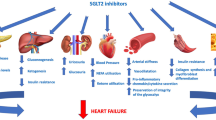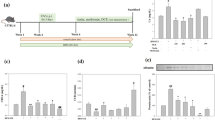Abstract
Background: Thioredoxin-interacting protein (Txnip), an inhibitor of thioredoxin (Trx), increases in diabetic nephropathy and promotes oxidative stress. The angiotensin II (Ang II) receptor blocker telmisartan may protect renal function in diabetic models and patients via multiple effects including antioxidation. However, its mechanism has not been fully elucidated, and its relationship to Txnip remains unclear. Aim: This study aimed to investigate whether telmisartan ameliorates oxidative stress by regulating Txnip and Trx expression in Type 2 diabetic rat kidneys and explore the possible relationship between renoprotection by telmisartan and Txnip. Methods: Twenty-one rats were equally divided into control (C), streptozotocin-induced diabetic (D), and telmisartan-treated diabetic (T) groups. Txnip and Trx expression in rat kidneys was analyzed by immunohistochemistry, RTPCR, and western blot. Peroxisome proliferator-activated receptor-γ(PPARγ), NADPH oxidase activity, and parameters of renal function and oxidative stress were also measured. Results: Trx and PPARγ were significantly decreased, and Txnip expression and NADPH oxidase activity markedly increased, in the D and T groups compared to the C group. After telmisartan treatment, Trx and PPARγ were upregulated, while Txnip expression and NADPH oxidase activity were down-regulated. Parameters of renal function and oxidative stress were improved by telmisartan. Conclusion: Telmisartan ameliorates oxidative stress and protects renal function in Type 2 diabetic rat kidneys. The downregulation of Txnip by telmisartan may be associated with PPARγ activation.
Similar content being viewed by others
References
Forbes JM, Coughlan MT, Cooper ME. Oxidative stress as a major culprit in kidney disease in diabetes. Diabetes 2008, 57: 1446–51.
Advani A, Gilbert RE, Thai K, et al. Expression, localization, and function of the thioredoxin system in diabetic nephropathy. J Am Soc Nephrol 2009, 20: 730–41.
Hamada Y, Miyata S, Nii-Kono T, et al. Overexpression of thioredoxin1 in transgenic mice suppresses development of diabetic nephropathy. Nephrol Dial Transplant 2007, 22: 1547–57.
Schulze PC, Yoshioka J, Takahashi T, He Z, King GL, Lee RT. Hyperglycemia promotes oxidative stress through inhibition of thioredoxin function by thioredoxin-interacting protein. J Biol Chem 2004, 279: 30369–74.
Patwari P, Higgins LJ, Chutkow WA, Yoshioka J, Lee RT. The interaction of thioredoxin with Txnip. Evidence for formation of a mixed disulfide by disulfide exchange. J Biol Chem 2006, 281: 21884–91.
Fang S, Jin Y, Zheng H, et al. High glucose condition upregulated Txnip expression level in rat mesangial cells through ROS/MEK/MAPK pathway. Mol Cell Biochem 2011, 347: 175–82.
Qi W, Chen X, Gilbert RE, et al. High glucose-induced thioredoxin-interacting protein in renal proximal tubule cells is independent of transforming growth factor-beta1. Am J Pathol 2007, 171: 744–54.
Lakshmanan AP, Watanabe K, Thandavarayan RA, et al. Telmisartan attenuates oxidative stress and renal fibrosis in streptozotocin induced diabetic mice with the alteration of angiotensin-(1–7) Mas receptor expression associated with its PPAR-gamma agonist action. Free Radic Res 2011, 45: 575–84.
Nishiyama A, Nakagawa T, Kobori H, et al. Strict angiotensin blockade prevents the augmentation of intrarenal angiotensin II and podocyte abnormalities in type 2 diabetic rats with microalbuminuria. J Hypertens 2008, 26: 1849–59.
Hasegawa G, Fukui M, Hosoda H, et al. Telmisartan, an angiotensin II type 1 receptor blocker, prevents the development of diabetes in male Spontaneously Diabetic Torii rats. Eur J Pharmacol 2009, 605: 164–9.
Nakayama M, Inoguchi T, Sonta T, et al. Increased expression of NAD(P)H oxidase in islets of animal models of Type 2 diabetes and its improvement by an AT1 receptor antagonist. Biochem Biophys Res Commun 2005, 332: 927–33.
Wenzel P, Schulz E, Oelze M, et al. AT1-receptor blockade by telmisartan upregulates GTP-cyclohydrolase I and protects eNOS in diabetic rats. Free Radic Biol Med 2008, 45: 619–26.
Benson SC, Pershadsingh HA, Ho CI, et al. Identification of telmisartan as a unique angiotensin II receptor antagonist with selective PPARgamma-modulating activity. Hypertension 2004, 43: 993–1002.
Matsui T, Yamagishi S, Ueda S, et al. Telmisartan, an angiotensin II type 1 receptor blocker, inhibits advanced glycation end-product (AGE)-induced monocyte chemoattractant protein-1 expression in mesangial cells through downregulation of receptor for AGEs via peroxisome proliferator-activated receptor-gamma activation. J Int Med Res 2007, 35: 482–9.
Watanabe M, Inukai K, Sumita T, et al. Effects of telmisartan on insulin resistance in Japanese type 2 diabetic patients. Intern Med 2010, 49: 1843–7.
Qi W, Chen X, Holian J, Tan CY, Kelly DJ, Pollock CA. Transcription factors Kruppel-like factor 6 and peroxisome proliferator-activated receptor-{gamma} mediate high glucose-induced thioredoxin-interacting protein. Am J Pathol 2009, 175: 1858–67.
Billiet L, Furman C, Larigauderie G, et al. Enhanced VDUP-1 gene expression by PPARgamma agonist induces apoptosis in human macrophage. J Cell Physiol 2008, 214: 183–91.
Oka S, Masutani H, Liu W, et al. Thioredoxin-binding protein-2-like inducible membrane protein is a novel vitamin D3 and peroxisome proliferator-activated receptor (PPAR)gamma ligand target protein that regulates PPARgamma signaling. Endocrinology 2006, 147: 733–43.
Chutkow WA, Birkenfeld AL, Brown JD, et al. Deletion of the alpha-arrestin protein Txnip in mice promotes adiposity and adipogenesis while preserving insulin sensitivity. Diabetes 2010, 59: 1424–34.
Yang XY, Sun L, Xu P, et al. Effects of salvianolic acid A on plantar microcirculation and peripheral nerve function in diabetic rats. Eur J Pharmacol 2011, 665: 40–6.
Chu KY, Lau T, Carlsson PO, Leung PS. Angiotensin II type 1 receptor blockade improves beta-cell function and glucose tolerance in a mouse model of type 2 diabetes. Diabetes 2006, 55: 367–74.
Li JM, Shah AM. Intracellular localization and preassembly of the NADPH oxidase complex in cultured endothelial cells. J Biol Chem 2002, 277: 19952–60.
Zhang L, Tu H, Li YL. Angiotensin II enhances hyperpolarization-activated currents in rat aortic baroreceptor neurons: involvement of superoxide. Am J Physiol Cell Physiol 2009, 298: C98–106.
Yamawaki H, Berk BC. Thioredoxin: a multifunctional antioxidant enzyme in kidney, heart and vessels. Curr Opin Nephrol Hypertens 2005, 14: 149–53.
Panchapakesan U, Sumual S, Pollock CA, et al. PPARγ agonists exert antifibrotic effects in renal tubular cells exposed to high glucose. Am J Physiol Renal Physiol 2005, 289: F1153–8.
Cha DR, Zhang X, Zhang Y, et al. Peroxisome proliferator activated receptor alpha/gamma dual agonist tesaglitazar attenuates diabetic nephropathy in db/db mice. Diabetes 2007, 56: 2036–45.
Gokulakrishnan K, Mohanavalli KT, Monickaraj F, Mohan V, Balasubramanyam M. Subclinical inflammation/oxidation as revealed by altered gene expression profiles in subjects with impaired glucose tolerance and Type 2 diabetes patients. Mol Cell Biochem 2009, 324: 173–81.
Kuppan G, Balasubramanyam J, Monickaraj F, Srinivasan G, Mohan V, Balasubramanyam M. Transcriptional regulation of cytokines and oxidative stress by gallic acid in human THP-1 monocytes. Cytokine 2010, 49: 229–34.
Saitoh Y, Hongwei W, Ueno H, Mizuta M, Nakazato M. Telmisartan attenuates fatty-acid-induced oxidative stress and NAD(P)H oxidase activity in pancreatic beta-cells. Diabetes Metab 2009, 35: 392–7.
Arner ES, Holmgren A. Physiological functions of thioredoxin and thioredoxin reductase. Eur J Biochem 2000, 267: 6102–9.
Shaked M, Ketzinel-Gilad M, Ariav Y, Cerasi E, Kaiser N, Leibowitz G. Insulin counteracts glucotoxic effects by suppressing thioredoxin-interacting protein production in INS-1E beta cells and in Psammomys obesus pancreatic islets. Diabetologia 2009, 52: 636–44.
Saitoh Y, Hongwei W, Ueno H, et al. Telmisartan attenuates fatty-acid-induced oxidative stress and NAD(P)H oxidase activity in pancreatic beta-cells. Diabetes Metab 2009, 35: 392–7.
Storka A, Vojtassakova E, Mueller M, et al. Angiotensin inhibition stimulates PPARgamma and the release of visfatin. Eur J Clin Invest 2008, 38: 820–6.
Author information
Authors and Affiliations
Corresponding author
Additional information
J. Wu and H. Lin contributed equally to this work.
Rights and permissions
About this article
Cite this article
Wu, J., Lin, H., Liu, D. et al. The protective effect of telmisartan in Type 2 diabetes rat kidneys is related to the downregulation of thioredoxin-interacting protein. J Endocrinol Invest 36, 453–459 (2013). https://doi.org/10.3275/8764
Accepted:
Published:
Issue Date:
DOI: https://doi.org/10.3275/8764




